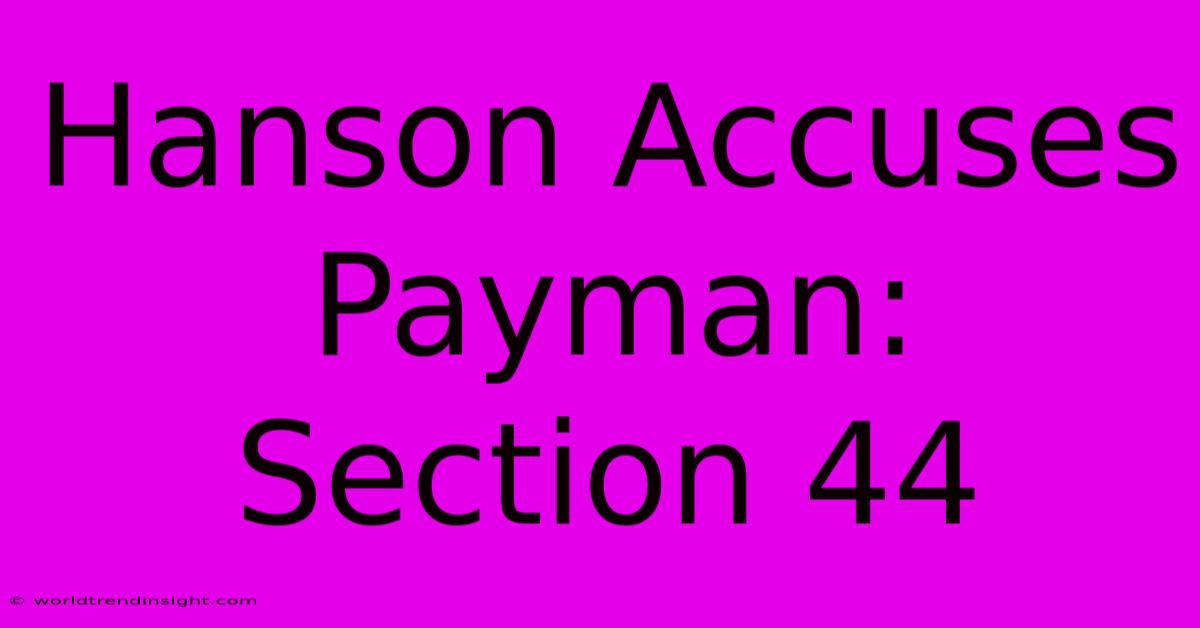Hanson Accuses Payman: Section 44

Discover more detailed and exciting information on our website. Click the link below to start your adventure: Visit Best Website Hanson Accuses Payman: Section 44. Don't miss out!
Table of Contents
Hanson Accuses Payman: Decoding Section 44 and its Implications
Hey everyone, so you're probably here because you've heard whispers – or maybe shouts – about this whole Hanson vs. Payman thing, specifically Section 44. It's a wild ride, let me tell you. I've spent the last few weeks knee-deep in legal jargon, trying to make sense of it all, and honestly? It's a mess. But I'll do my best to break it down in plain English, sharing my own struggles and what I've learned along the way.
This isn't some dry legal analysis, though I'll try to be accurate. This is me, spilling the tea on my journey through understanding Section 44, the part where things get really messy between Hanson and Payman. Buckle up, buttercup.
My Initial Confusion: A Total Swamp of Legalese
First off, let me confess: I initially thought Section 44 was some kind of obscure tax code. I pictured some dusty, forgotten law book, full of tiny print and even tinier loopholes. Boy, was I wrong. It turns out Section 44 (assuming we're talking about the same legal framework – always double-check!), in this context, deals with something much more... juicy. It deals with allegations of breach of contract, specifically related to the performance of the contract.
It's all about the specifics of what was agreed upon, and whether those agreements were met. Were there deadlines missed? Were there deliverables that were, shall we say, subpar? Did the terms get renegotiated along the way, and if so, were those changes documented properly? This is where the rubber meets the road, folks.
Understanding the Allegations: What Hanson Claims
From what I've gathered (and again, I'm not a lawyer!), Hanson's accusations center around Payman's alleged failure to meet certain crucial obligations outlined in Section 44. This might involve missed deadlines, inadequate quality of work, or maybe even a complete failure to deliver on promised services. It's unclear from just the headlines, but the legal documents probably lay it all out.
I spent hours reading snippets and summaries online, trying to piece together the narrative. The articles were all over the place – some were clickbait, some were overly technical, and some seemed downright biased. It was frustrating!
Tip 1: Don't rely on single sources. Cross-reference information across multiple reliable news outlets and legal blogs to get a more balanced understanding.
Tip 2: Look for the original documents. If possible, try to find the actual court filings or legal documents. They will be the most accurate source of information.
The Importance of Clear Contracts: A Lesson Learned
This whole mess really highlights the importance of having a crystal-clear contract. I made this mistake once in a smaller project, and it almost cost me a fortune. I thought a handshake agreement was enough, but boy was I wrong. Things went south quickly, and I learned the hard way that a well-written, detailed contract is your best friend.
Tip 3: Always have a lawyer review your contract. Even if it seems straightforward, a professional can spot potential issues you might miss. It's worth the investment to avoid costly legal battles down the road. I've seen a lot of cases like this. It's never pretty.
Moving Forward: What to Expect
The Hanson vs. Payman case involving Section 44 is still ongoing, so predicting the outcome is impossible. But one thing's for sure: this case serves as a cautionary tale about the importance of meticulous contract drafting and the potential consequences of failing to meet contractual obligations. I'll keep you updated as I can, but remember to do your own research! This has been a wild ride, and I hope this messy, rambling post helped make some sense of it all! Let me know in the comments if you have any questions or insights. We can all learn from each other's mistakes.

Thank you for visiting our website wich cover about Hanson Accuses Payman: Section 44. We hope the information provided has been useful to you. Feel free to contact us if you have any questions or need further assistance. See you next time and dont miss to bookmark.
Featured Posts
-
Usa Chl Prospects Challenge 2024 Officials
Nov 27, 2024
-
Suryavanshi 13 Year Old Ipl Player
Nov 27, 2024
-
Bayern Defeats Psg Kim Scores
Nov 27, 2024
-
Gvardiols Man City Flop Early Struggles
Nov 27, 2024
-
Barcelona Ucl Game Brest Live Stream
Nov 27, 2024
